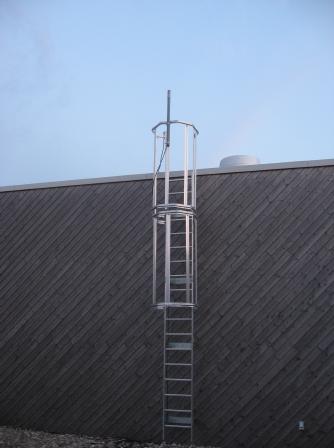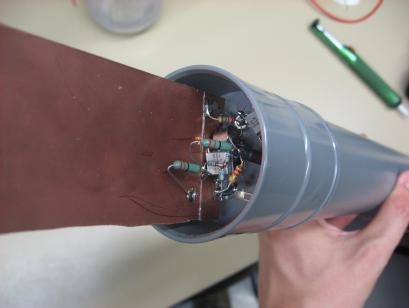
PI4THT

 |
Amateur radio club ETGD PI4THT |
Faculty for Electrical Engineering, Mathematics and Computer Science |  |
|||
|
|
||||||
Yesterday evening we finally installed the antenna, and
the WebSDR server is now finally operational again!
In the end, we were offline for 1 year, 8 months and 5 days.
We'll still have to see how well the new antenna performs.
For now, the system has been configured for 8 bands of each 600 kHz wide.
In future, we intend to install a system with continuous coverage
like the experimental system that has been active from my (PA3FWM's)
home.


Update May 25:
We have obtained permission to mount the antenna semi-permanently at the place where we successfully tested it earlier (see below). However, in the discussions with people from the university's facility services about this, it turned out that our planned mounting point was not yet properly grounded for lightning protection, which is needed when we attach an antenna there. They have ordered proper lightning protection to be installed; when that's done, we can mount the antenna.
Update April 19:
New tests done, after designing and building a low-pass filter for the Mini-Whip.
The resulting waterfall displays can be seen
here.
Clearly, the noise around 7 MHz is gone now, so thas was probably indeed
caused by overload due to FM broadcast transmitters.
The band now looks quite clean, with lots of amateur signals visible and
audible.
Unfortunately, there's a lot of QRM on 80m, of which the cause is unknown.
Next step: mounting this antenna in a (semi-)permanent way.
Update April 5:
Some more testing done, with the Mini-Whip again temporarily installed
but this time in an (almost) watertight enclosure and on a little pole.
See here for a picture of the waterfall
displays.
The noise level jumps back and forth between two levels, mostly
notable on 80m, 40m and 30m bands. We later found that this variation
was due to a flaky ground connection;
with the ground connection solidly attached, the noise is low.
There's some broadband noise covering the low end of 40m.
This may well be an intermodulation product of two nearby FM broadcast
transmitters on 93.7 and 100.7 MHz; if so, then a simple low-pass filter
at the input of the active antenna should solve this.
All across 80m the noise also seems high; the cause of this is as yet
unknown.
The waterfall at the bottom shows a frequency range near 27 MHz;
the very strong signal here is a pager transmitter (for the university's
safety personnel) located on the same building as we are. Fortunately,
it looks like it doesn't overload the active antenna, because there's
no correlation visible between its transmissions and the noise level
in the other bands.
Because the antenna was mounted in a very provisional way, we couldn't
leave it running. But we're slowly getting there... :-)
Update 29 March 2012:
Tonight (we usually work on this on our club evening on Thursday)
we profited from the evening light (due to spring days and daylight
saving time), to semi-permanently install a cable to the planned
antenna location on the roof.
Some people asked what kind of active antenna we're experimenting
with: the most promising one so far is a PA0RDT Mini-Whip.
To be continued...
Update 8 March 2012:
Some more tests done, with the active antennas now placed at a different location on the roof and with better grounding. The results were a lot better and quite encouraging, although not perfect yet. To be continued...
Update 23 February 2012:
We did tests with two active antennas. Unfortunately, the noise level they received was way too high: only the strongest broadcast signals were audible. Since the top part of the building is all metal, I don't think so much noise can leak out of the building. More likely, either both active antennas are broken, or they picked up this noise due insufficient grounding. To be continued...
Update 14 February 2012:
We made another step forward: we got a key with which we can open the door that gives us access to the roof, so we can now physically go to the other side of our hole in the wall, and thus actually do something with cables that we feed through the hole...
Update 25 November 2011:
Yes!
Yesterday, the hole in our wall was installed, as demonstrated by the
below picture, showing some daylight coming in through the pipe through the wall.
It's not so clear in this picture, but the pipe is more than 25 cm long, and finishes on
the outside with a 45 degree bend downwards, to keep rainwater out.
Next challenge is to mount some temporary antenna on the outside...

Update 17 November:
Finally good news: we've been told that next week the hole in the
wall will be made for us!
We won't be able to install our big masts and beam antennas (for the
club's use) yet, but a wire or active whip for the WebSDR should be
possible soon!
Update 1 September:
By popular request, here's an update:
Unfortunately, there is still no real progress, but based on regular
communication with several people in the faculty, we have good reason
to believe that in the end we will get antenna facilities; it just takes
much longer than I even imagined...
Update 28 February:
Don't despair, we still intend to bring our receiver online again, but the antenna cable feedthrough still has not been installed. However, we did recently hear that a list is being made of all the minor changes that still need to be made to the building, and that our antenna facilities are also on that list.
Update 4 January:
Happy new year everyone!
Unfortunately, there's no news yet about our antenna connection.
Thanks for all the mails I got, expressing support and/or with tips
on how to feed an antenna signal through a window that cannot be opened.
Unfortunately, those tips are not usable: our only window is to the
corridor, not to the outside. That is because our club room is in a
part of the building that originally was only meant for storage, so
no outside windows were installed.
Update 16 December 2010:
It looks like it will take a while more before we can install an outside antenna.
Today I've done a preliminary experiment with an indoor antenna, but that
was not yet successful.
Several people have e-mailed me with the suggestion to use a flat cable feed-through
for windows.
Unfortunately, our new room does not have a suitable window for that.
Update 26 November 2010:
We're back -- well, somewhat.
Over the past couple of weeks, we have moved all our stuff to our new club room (although much of it still
has to be unpacked),
and since yesterday, we have an internet connection there.
Unfortunately though, we do not yet have any possibilities for feeding an antenna cable through the wall.
It is also still very unclear how long it will take until it this will be arranged.
Background:
Since Wednesday November 3 (2010), this WebSDR receiver has been offline. This is because the radio club at the University of Twente, where this receiver is hosted, had to move to a new building, along with the entire department of electrical engineering. We knew this was coming and we were busy preparing the move (dismantling our antennas, packing our equipment, etc.). On October 29 we were told that we had to empty the old room by November 4, which is earlier than we expected. That's why we could not announce this more in advance, and could not make the transition smooth by first preparing the new room.
73, Pieter-Tjerk, PA3FWM (e-mail about this topic: qrt AT websdr.org)